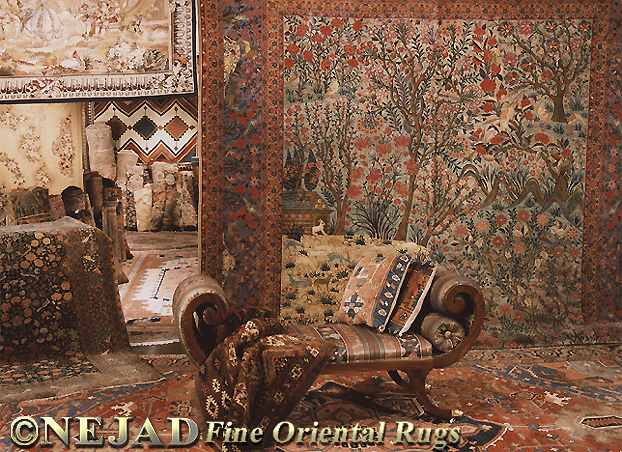
Antique kilims from Anatolia, Persia, and Russia are not only a wonderful choice
for adding beautiful colors and design to your décor, they are also living
representations of the cultures and traditions that created them. As “Floor
Art” their weave techniques, colors, and motifs tell stories of the people,
their beliefs, and their lives.

Nejad Rugs in historic Doylestown, Bucks County, Pennsylvania, offers one of the
most important collections of antique oriental rugs & kilims in the United States.
Whether you are a collector, a decor enthusiast, or someone who appreciates the
beauty and history of kilims, the collection at Nejad Rugs is sure to inspire and
fascinate.

The weaving techniques of kilims vary significantly across Anatolia, Persia, and
Russia, each adapting to the local environment and available materials. Anatolian
kilims, for example, are known for their slit weave technique, which involves
weaving tight vertical slits into the rug for color separation. This technique
allows for the creation of sharp patterns and is particularly suited to the
geometric designs common in these rugs.

Persian kilims, on the other hand, often use a combination of flat weaving and
embroidery, adding texture and depth to their designs. This hybrid technique
results in a more diverse palette of patterns, from the floral to the geometric,
allowing for intricate detailing.

Russian kilims, especially those from the Caucasus region, are distinctive for
their sumak weave. This technique involves wrapping wefts over the warps, creating
a herringbone-like pattern that adds strength and texture to the rug. This method
allows for detailed and complex designs, often featuring bold, geometric patterns.

The colors in kilims are not just for decoration; they carry meanings and symbolize
various aspects of life, such as happiness, protection, and fertility. Traditionally,
the dyes used were natural, derived from plants, minerals, and sometimes insects. In
Anatolia, madder root was commonly used for reds, indigo for blues, and walnut shells
for browns and blacks. These natural dyes give Anatolian kilims their rich, warm tones.

Persian kilims often feature a vibrant palette, utilizing a wider range of natural
dyes. The introduction of synthetic dyes in the late 19th century brought brighter
colors, but many weavers continue to prefer traditional methods for their depth and
quality of color.

Russian kilims, particularly those from the southern regions, display a restrained color
scheme, often dominated by reds and blues. The use of natural dyes, especially those
derived from local flora, is prevalent, giving these kilims a distinctive, earthy palette.

The motifs in kilims are deeply symbolic, each with its own story and significance. In
Anatolia, common motifs include the ram’s horn, symbolizing masculinity and power; the
hands-on-hips motif, representing motherhood and fertility; and the evil eye, offering
protection against bad luck.

Persian kilims are replete with floral motifs, each with its own symbolism. Roses signify
love and mystery, while the tree of life represents eternal life. Animals are also common
motifs, with each creature carrying its own symbolic weight; for example, lions for power
and peacocks for immortality.

Russian kilims often feature motifs inspired by the natural world, with a particular
emphasis on symbols of protection and prosperity. Geometric patterns, such as the
diamond, symbolize the female form and fertility, while animals and birds are believed
tooffer protection and good luck to the household.

Antique kilims from Anatolia, Persia, and Russia are not merely artifacts of the past;
they are living representations of the cultures and traditions that created them. Their
weave techniques, colors, and motifs tell stories of the people, their beliefs, and their
lives. Nejad Rugs in Doylestown, Bucks County, Pennsylvania, offers a gateway to exploring
these beautiful and meaningful textiles, providing a touchpoint for those interested in the
rich tapestry of history they represent. Whether you are a collector, a decor enthusiast,
or someone who appreciates the beauty and history of kilims, the collection at Nejad Rugs
is sure to inspire and fascinate.
By understanding the intricacies of these kilims, we gain insight into the diverse cultures
and histories of the regions they come from. These rugs do more than adorn floors; they
weave the rich tapestries of human history and culture into the fabric of our daily lives.
